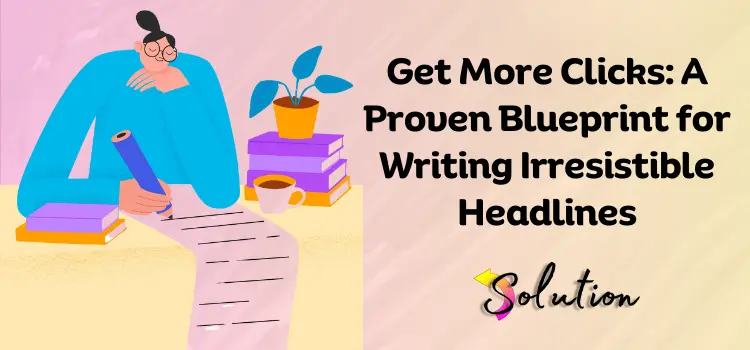
There are hundreds of blogs and resources available across the internet that show why it’s important to write a compelling title that drives traffic. We are not going to waste your time again with something that you’re already informed of.
Let’s be factual…
According to David Ogilvy, popularly recognized as the Father of Advertising, “Titles are read 5 times more than the body copy. If the title doesn’t capture the reader’s attention, then the rest of the content may go unread.”
So, what’s the definition of a good and powerful title?
The answer is not always straightforward, but it typically movies around marketing efforts and their results.
At the end of the day, being a marketer, what results did you expect from the title so that you can drive engagement with your target audience and can proudly showcase the success of your campaign?
Even if you’re reading this blog, it means our marketing guy was successfully able to craft a title that caught your attention and drew you in.
And we hope you already know the importance of a strong and powerful title; that’s why you’re reading this blog. Therefore, we will respect your time by not revisiting these fundamental concepts repeatedly.
Golden Rules for Crafting Titles That Attract Audiences Like a Magnet
Next time, when you’re working on crafting a compelling title for your next blog, follow these two: the 4Cs and 4Ps rules, and make sure to connect with the word magician behind these rules—Olivia (yupp, that’s me).
The piece was crafted with expertise and presented with impact and intention.
The 4Cs of a Great Title:
- Clear: Make sure the title is easy to understand and reflects what the blog is all about.
- Concise: Keep it short and concise within 6-7 words (55-60 characters).
- Compelling: Spark curiosity, and engage emotions and urgency – a perfect reason to give readers a reason to click.
- Credibility: Avoid clickbait – make sure the title accurately represents the content behind it.
The 4Ps of a Powerful Title:
- Promise: Tell your readers what value they will get. Discuss the problem that you’re discussing.
- Picture: Use words that help the readers to visualize the benefit or outcome.
- Proof: Support the title with stats, results, or a credible tone.
- Push: Create urgency and encourage action with strong language.
Top Marketer’s Proven Blueprint for Crafting Irresistible Titles
What if we show you the exact roadmap and blueprint that top marketers use to craft irresistible titles that drive clicks and engagement?
In this section, we will give you the proven blueprint and the strategies to create powerful titles that not only grab attention but also drive results for your content.
1. Understand the Reader’s Mindset
Your journey to write a compelling blog title commences automatically after you think of the topic, not when you start typing.
You will be surprised to know that the best titles don’t start with a catchy phrase—they start with a catchy and fair understanding of “What does my reader truly want?”
Whether you’re just a content writer or a top-level marketing manager, if you don’t know whom you are writing for and what they are looking for, then all the hard work will be vanished in a thunderstorm.
So, instead of directly moving to the main task of choosing the right words for your title, make sure to invest your time in filtering out what your target audience is interested in and what will grab their attention.
2. Use Proven Power Structures
There are various magical headline formulas that turn the scratch words into captivating titles. These are not gimmicks; they are the frameworks that have been tested and proven to be effective in capturing the interest of readers.
By utilizing these power structures, you can create headlines that are not only attention-grabbing but also compelling enough to drive engagement and click-through rates.
Here are some of the most effective and tried-and-tested heading formulas that you can incorporate to create compelling headlines within a few seconds:
- How to Headlines: How to Lose Fat and Build Muscle at the Same Time?
- Numbered Lists: #7 Mistakes You Might Be Making in Your Daily Skincare Routine
- Question Headlines: Are You Making These Common SEO Mistakes Without Even Realizing It?
- Command Headlines: Stop Wasting Money on Ads That Don’t Convert—Do This Instead
- Secrets and Insider Tips: The Secret Strategy Top Bloggers Use to Triple Their Traffic
- Comparison Headlines: Instagram vs. TikTok: Which Platform Is Better for Your Brand in 2025?
- Benefit-Driven Headlines: Get 3x More Leads Without Spending Extra on Ads—Here’s How
Remember that an intriguing headline doesn’t mean anything if it doesn’t do what it says it will do. Once you have a fantastic title, make sure the content lives up to the hype. A catchy title is what gets people to read your work; worth is what keeps them reading and coming back for more.
3. Test and Optimize Your Titles (A/B Testing)
Don’t think that the first draft is the best one. Even marketers with a lot of experience test their headlines in different places, like on web pages, emails, and social media.
How it works: Data is better than gut feelings. To determine the most effective headline for your audience, test at least two different versions and monitor metrics such as CTR (click-through rate) or bounce rate.
Try the ads for “10 Tools Every Marketer Needs” and “10 Life-Saving Tools Every Marketer Swears By” and see which ones get more clicks.
4. Use Triggers
Feelings are what sell. Titles that make people keen to know more, act quickly, feel like they might miss out (FOMO), or get excited tend to do better than neutral ones.
Tip: Depending on the tone and goal of your content, use strong words like “unbelievable,” “essential,” “jaw-dropping,” “urgent,” and “breakthrough.”
Example: “The Mind-Blowing Plan That Earned Us 100,000 Views in Seven Days.”
5. Personalize for the Reader
Want your blog names to be more relatable right away? Start talking to your fans straight on. If you want to talk to a specific group, like freelancers, marketers, owners, etc., use words like “you” and “your.”
It makes them feel like they know you and your title, like it was written just for them. People are a lot more likely to click when they believe you see them. We assure you that this minor alteration effectively captures people’s attention and maintains their interest.
Example: “Why Freelance Designers Are Losing Clients—And How You Can Avoid It”
Also Look:- The Secret Sauce to Writing Meta Descriptions That Actually Work
Conclusion
Your blog title is the first thing people see and sometimes the only thing that gets their attention. It’s your hook, your main idea, or your first sentence. What if it doesn’t land? Your other content might never get the attention it needs. Now you know how to make titles that people can’t resist.
Use the 4Cs and 4Ps, power structures, emotional hooks, personalization, and testing to make titles that get clicks and real engagement. What is the most effective approach?
These strategies are effective and reusable. When you sit down to write next, don’t just write a headline—make a call to action. Not only do great names garner attention, but they also facilitate action. Are you ready to make your next one stand out?


